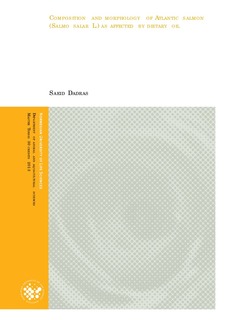| dc.description.abstract | A feeding experiment was conducted to examine the effect of diets high or low in rapeseed and additionally the effect of protein supplementation of diets rich in rapeseed oil in feed for farmed Atlantic salmon (Salmo salar L.). The aim was to investigate the impact on growth performance, slaughter parameters, total lipid content and fatty acid profile in skeletal muscle, intestine, liver and heart, together with the impact on health related parameters such as organ morphology, heart fat, and also liver color and patches. The salmon were fed extruded dry feed containing 35.6% fat and 41.4% protein during August-December, and 37.7% fat and 34.6% protein during December-March. The lipid source was either 70% marine and 30% rapeseed oil in the Marine+ group or 30% marine and 70% rapeseed oil in Control group (commercial standard). The third diet, Protein+ was same as Control diet added an extra protein (2%) which was extracted from fish skin (triplicate net-pens per treatment). Fish weights and lengths were measured in October, December and March. Initial weight of the salmon in August was 2.5 kg.
There were no significant differences in final weight (mean weight of 6.5 kg), TGC and FCR due to the dietary treatments. However, the Protein+ and Control group had higher condition factor compared to the Marine+ group. Significantly lower CF of the Marine+ group coincided with higher fork length and lower fillet yield. The Control group showed significantly highest viscera-somatic index, visual visceral fat and visual heart fat, whereas these were lowest in the Protein+ group. It was possible to stimulate increased muscle building by providing extra protein into commercial salmon feed, since the slaughter and fillet yield of the Protein+ group increased significantly by 0.9% and 1.6%, respectively. The fatty acid profile of all organ tissues examined was significantly altered due to the dietary treatment, where 18:1n-9 changed most significantly. There were higher levels of n-3 fatty acids, such as of eicosapentaenoic acid (EPA) and docosahexaenoic acid (DHA) in the Marine+ group. On the other hand, n-6 fatty acids and C18 fatty acids, such as 18:1n-9 and 18:2n-6 were presented in a higher amount in the Control group. Consequently, the n-3/n-6 fatty acids ratio was higher in the Marine+ group and fish in the Control group had the lower ratio.
In conclusion, the present study suggests that addition of 2% extra protein from fish skin to salmon diets rich in rapeseed oil is beneficial in terms of stimulating muscle growth and counteracting fat accumulation cost by high levels of rapeseed oil. | no_NO |
